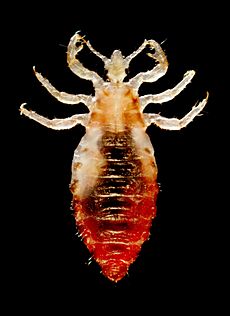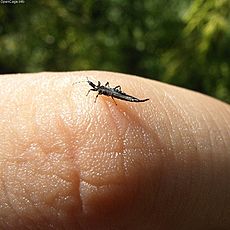Parapneuroptera facts for kids
Quick facts for kids Parapneuroptera |
|
|---|---|
 |
|
| Magicicada septendecim, a cicada (Hemiptera) | |
| Scientific classification | |
| Kingdom: | |
| Phylum: | |
| Class: | |
| Subclass: | |
| Infraclass: | |
| Superorder: |
Paraneoptera
|
| Orders | |
|
Psocoptera – bark lice Phtiraptera – lice Thysanoptera – thrips Hemiptera – true bugs |
|
Paraneoptera is a monophyletic superorder of insects.
It includes four orders, the bark lice, true lice, thrips, and hemipterans, the true bugs.
The mouthparts of the Paraneoptera reflect diverse feeding habits. Basal groups are microbial surface feeders, whereas more advanced groups feed on plant or animal fluids.
Contents
Hemiptera
Hemiptera is an order of insects often known as the true bugs (bug). They are about 50,000–80,000 species of cicadas, aphids, planthoppers, leafhoppers, shield bugs, and others. They range in size from 1 millimetre (0.039 in) to around 15 centimetres (5.9 in), and share a common arrangement of sucking mouthparts.
Psocoptera
Psocoptera, the bark lice, include 4,400 described species arranged in 3 suborders. There are 50 families of bark lice with over 200 genera. This is the first insect order to show the beginnings of a transition to sucking mouthparts. It is sister group to the Phthiraptera. Bark lice are found on foliage, under bark, or in leaf litter.
Phthiraptera
Phthiraptera, the lice, includes 5,000 described species divided into 4 suborders.
The body of a louse is dorsoventrally flattened and the eyes are absent or nearly so. The legs are strong for holding onto fur or feathers of the host. All species of lice are parasitic. Lice parasitise all orders of birds and most orders of mammals.
Thrips
Order Thysanoptera includes 5,500 species classified into two suborders. These insects are called thrips.
The mouth is in the form of an asymmetrical mouth cone, consisting of piercing stylets. Thrips are commonly found on and in flowers. Most species are phytophagous, feeding on flowers.



